Article by Jeanne Gozigian
| Common name | Botanical name | Plant family |
|---|---|---|
| Venus flytrap | Dionaea muscipula | Droseraceae |
| American pitcher plant | Sarracenia spp. | Sarraceniaceae |
| Bladderworts | Utricularia spp. | Lentibulariaceae |
| Sundews | Drosera spp. | Droseraceae |
This Plant of the Month article should probably have been featured for the month of October and Halloween, as the subject is the mysterious and creepy world of carnivorous plants! There are an amazing number of them worldwide and more in the continental USA than you might have guessed.
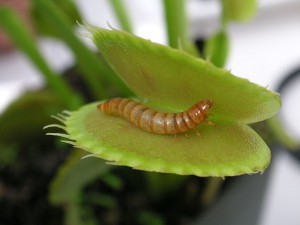
Meal worm in venus fly trap. (Photo: Beatrice Murch)
Most people have probably heard of the Venus flytrap, which grows in the wild on the eastern coast of the United States, mainly in the wetlands of North and South Carolina. In fact, most of them are within a 60-mile radius of Wilmington, North Carolina. It is the official state carnivorous flower of North Carolina. There are fewer than 35,000 wild Dionaea muscipula specimens on sites owned by the Nature Conservancy, the state government of North Carolina, and the United States military.
Venus flytraps are considered to be vulnerable, although not on the verge of extinction, because poachers regularly take huge swaths of them to sell to nurseries and collectors. In 1760, the governor of North Carolina, Arthur Dobbs, called these plants, “the greatest wonder of the vegetable kingdom…upon touching the leaves, they instantly close like a spring trap”. This fascination extends to many people who wish to own some of these plants, insuring the continued poaching – often by multi-generational families.
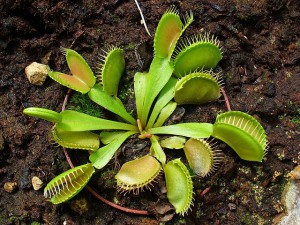
Dionaea muscipula, Droseraceae, Venus Flytrap, leaves; Botanical Garden KIT, Karlsruhe, Germany. (Photo: H. Zell)
Dionaea muscipula was named by 18th century Swedish naturalist Carl Linnaeus, who considered the Venus flytrap “against the order of nature”. Venus was the Roman goddess of love, the Greek love goddess was Dionea/Aphrodite, and muscipula means mousetrap. It is a monotypic genus closely related to sundews, another genus of carnivorous plants. The herbaceous perennial Venus flytrap, sometimes called “Red Dragon”, features a “snap trap”, shared only by common ancestor Aldrovanda, another Drosera, which is now extinct.
It is thought that the snap trap evolved as a specialized type of “foliar feeding”, needed by plants growing in nutrient-poor soil, like that of the Carolina bogs and savannas. It supplemented the ordinary photosynthesis of herbaceous plants with animal protein. The traps are specialized leaves arising from short stems, 3-10 centimeters, similar to bulbs. Each plant has a rosette of 4-7 leaves; if there are more than 7 leaves, the plant has naturally divided to form more plants. The heart-shaped traps are the true leaves and the petioles are capable of photosynthesis. The traps are red in the center and are surrounded by cilia and the inside has 4 “trigger hairs” and a sweet smelling, mucilaginous nectar.
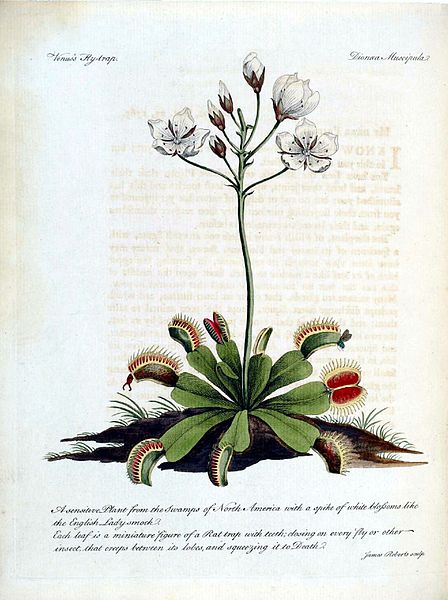
Plate from John Ellis’ “A Botanical Description of the Dionoea muscipula” in the same volume. HI Library call no. MC1 E47D.
Venus flytraps are selective predators; their diet of small insects consists of 33% ants, 30% spiders, 10% beetles, 10% grasshoppers, and 5% flying insects. When an insect approaches, lured by the nectar, he brushes the cilia on the side of the trap. Once inside, he brushes the first of the trigger hairs. Within 20 seconds of this, if he strikes a second trigger, the snap trap closes, taking only 1/10 of a second to do so. Movement of the prey within the trap stimulates the release of digestive hormones, which are acidic. If the insects are too small to be of nutritional use they are usually expelled, as is non-edible debris. Very occasionally, a large insect escapes, but not often. The process of trapping is not really understood. For further information see: Live sciences: “Venus Flytrap’s Speed Secret Revealed” web site.
The trap snaps closed, much like if one folded one’s hands together to form a cathedral. In 5-12 days all of the insect’s soft inner parts are absorbed. The trap opens and the insect’s tough exoskeleton is blown away by the wind or washed away by the rain. The specialized leaf/trap then dies but the energy the plant receives helps it to grow new leaves.
The plants can live to be 20-30 years old. Scapes of white flowers with greenish yellow centers grow directly from the roots and spring pollination results in formation of seeds, which can form new plants. Dionaea can tolerate mild winters. In nurseries, specimens are usually propagated in vitro using plant tissue cultures. Some people like to grow them at home in aquariums, using sphagnum moss as the medium. They must be fed live insects- ugh!
Thus the mystery! A Venus flytrap has no nervous system, muscles or tendons. Botanists speculate that electrical current or movement of water through the leaves may be involved, but the mystery remains.
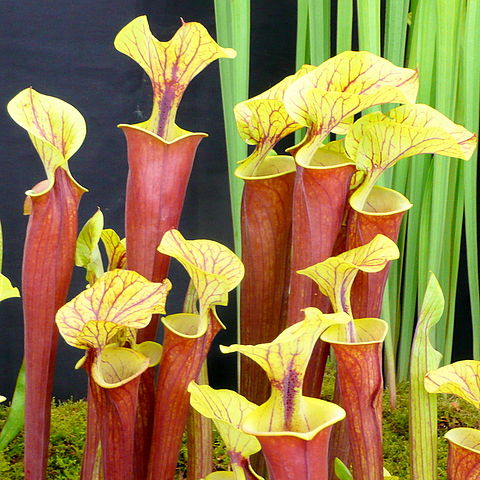
Pitcher plants; Sarracenia sp. (From geograph.org.uk) Credit: Jonathan Billinger.
But this is not the end of the story of carnivorous plants.
The American pitcher plant, Sarracenia spp., has what is called a passive pitfall trap. Here the specialized leaves that become traps in the Venus flytrap, form tubes. The smell of the nectar entices insects into the tubes. They are caught and enzymes digest them. The tubes have brilliant colors in some of the Sarracenia species, purples, reds and greens, which may also attract the insects. Pitcher plants occur in the coastal states of the southeastern Unites States, from Alabama to the Carolinas. There are 8-11 species of these North American beauties, sometimes called trumpet plants.
Bladderworts (Utricularia spp.) are another of the carnivorous plants that have passive traps. The visible part of the plant is the flower, as this rootless plant is mostly under the surface of the substrate (soil or water) in which it grows. Again, the traps are specialized leaves in the shape of a bladder. The trigger hairs are not active; they create a vacuum, sucking in water along with insects. There are over 200 species in the wild, worldwide.
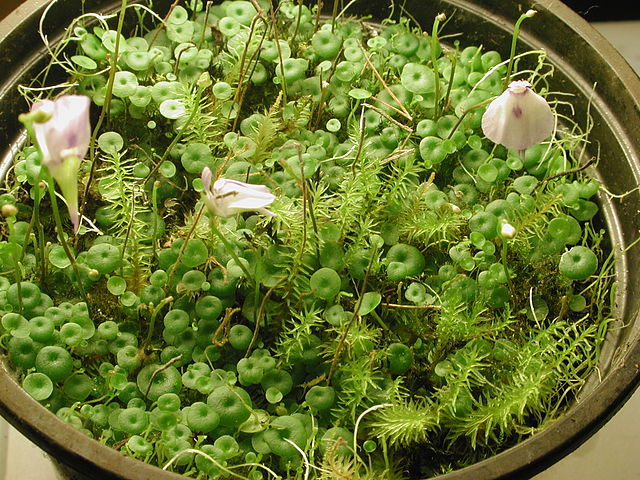
Credit: Petr Dlouhý

Drosera rotundifolia (Credit: Beth Zimmer).
Sundews (Drosera spp.) also occur worldwide. They are perennials that form rosettes with stems that can be prostrate or upright, from 1-100 cm., depending on the species. Some climbing varieties can reach 3 m. Mucilaginous glands tip hair-like tentacles with glistening, dewy drops, which are thick and sticky, catching insects much like being caught in a spider’s web. Sundews can live to be 50 years of age.
In mild climates these carnivores can also be grown outdoors, preferably in tubs for aquatic plants, with pure peat moss, watered with rain water or distilled water – very fussy if out of the wild. One could also dig a pond and line it with pond liner material. Naturally, outdoors they can catch their own bugs and do not have to be fed. This is possible to do if one is a dedicated fan of these unusual members of the botanical world.
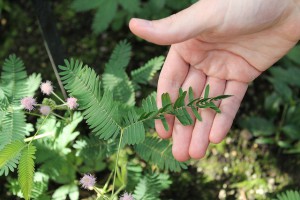
Mimosa pudica by Connie Ma. CC BY-SA 2.0
But, perhaps the snapping of the Venus flytrap is not as mysterious as we thought? There are other sorts of movement that occur in the plant world. Nastic movement is in response to a stimulus, as the trapping of insects in carnivorous plants, but also is seen in the leaves of Mimosa, which curl in response to touch, heat and cooling. Phototropism is exhibited by plants such as sunflowers turning toward or away from light sources. The twining of vines, such as morning glories, up a tree is fascinating to behold.
Ballistichory is a tactic used to send seeds far away from a mother plant. Fruits explode in a dramatic way in lupins (Lupinus, spp.) in the pea, or Fabaceae family, and the mallow family, Malvaceae, to aid is widespread seed dispersal. Plants, being rooted, cannot move from their substrates. So, while these types of movement are not as creepy as those of carnivorous plants, they are undoubtedly moving! Hmmmm…
Thanks to Janice Tucker and Helen Woody for proofreading this article.
Sources:
The Botanical Society of America
Live Science: “Venus Flytrap’s Speed Secret Revealed”, web site
Missouri Botanical Garden
National Geographic, ngm.nationalgeo.com
New York Times, November 28, 2016 article on Venus flytrap poaching
plantsinmotion.bio.indiana.edu/plantmotion/movements/nastic.html
theplantlist.org
University of Illinois at Urbana, plantbio/greenhouse/vt_carniverous.html
Wikipedia
www.countrysideinfo.co.uk/seeddisperl/index-2.htm


